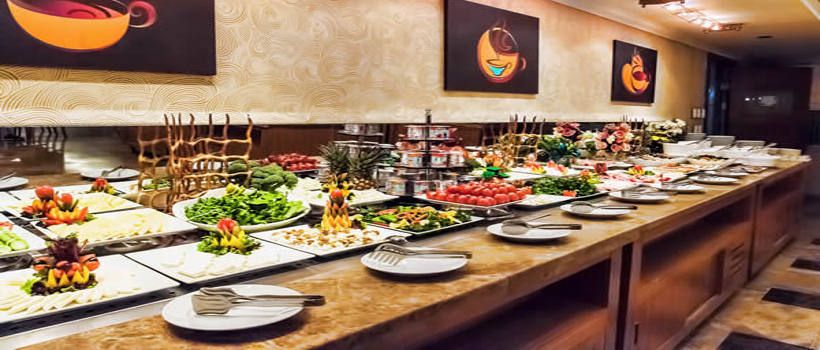Since food and beverage revenue can make up 20% of the total hotel revenue, it is important for hotels to offer quality food and beverages. There are various options that a hotel can implement in order to stay up-to-date in current market trends relating to culinary options.
Before deciding on a hotel to stay at, guests often evaluate many different attributes of a property such as its rooms, services, location, etc. Certainly, one of the most important aspects of an establishment that can be a deciding factor for a consumer is its food and beverage offerings. According to hospitalityupgrade.com, food and beverage revenue can make up to 20 percent of all hotel revenue or more. That is a significant part of a hotel’s P&L. Thus, it is clear how important full service restaurants and other F&B concepts are in attracting customers and driving incremental revenue for the hotel.
Additionally, a perfect combination of F&B services could become a competitive advantage for a hotel and a key factor for its differentiation from its competitors.
For a hotel to offer a unique and satisfactory F&B experience, it must implement culinary services and choices that coincide with the needs of the target market of guests staying at the hotel while also being in sync with evolving trends.  The following establishments are found in many upscale, full-service hotels. Examples of how a hotel can tailor the said offerings to meet the needs of a kid-friendly hotel and go above and beyond are as follows:
The following establishments are found in many upscale, full-service hotels. Examples of how a hotel can tailor the said offerings to meet the needs of a kid-friendly hotel and go above and beyond are as follows:
- Casual restaurant: Characters can come out and take pictures with children during the meal. In addition, the setting and table decorations can be for kids.
- Fine dining restaurant: The restaurant can still offer kid friendly, upscale food and even a baby-sitting service for kids to be occupied.
- Bar: A cocktail class can be offered for parents to have a fun experience and have some alone time.
- Lounge: The lounge can offer mocktails for children.
- Pool: Kid-friendly, and easy to eat finger food options can be available.
- On the go: Healthy options should be stocked in order to satisfy parents’ desires to feed their children nutritious snacks.
In addition to meeting the needs of the target market, a hotel must stay on top of evolving trends. Today, more and more customers who travel seek out new and exciting culinary experiences that they may have seen on TV or scrolled past online. Trends such as the rise of a more food-conscious culture is impacting the traditional notion of food options. Not only are consumers seeking healthier options with less fat, carbs, sugar etc, they also want to know where their food is coming from. “Organic” and “farm-to-table” have become major buzzwords in the F&B world. Guests are also more intrigued in local cuisines when staying in a new destination. People also love to learn about new things. And in many cases, they’re willing to pay for this knowledge. Consider offering classes, such as wine and cheese pairings or how to make craft cocktails, to guests to boost revenue. Lastly, convenience is key. Fast casual establishments are in, as this type of eatery combines quality with efficiency. Guests can also enjoy customization with a fast casual concept.
Trends such as the rise of a more food-conscious culture is impacting the traditional notion of food options. Not only are consumers seeking healthier options with less fat, carbs, sugar etc, they also want to know where their food is coming from. “Organic” and “farm-to-table” have become major buzzwords in the F&B world. Guests are also more intrigued in local cuisines when staying in a new destination. People also love to learn about new things. And in many cases, they’re willing to pay for this knowledge. Consider offering classes, such as wine and cheese pairings or how to make craft cocktails, to guests to boost revenue. Lastly, convenience is key. Fast casual establishments are in, as this type of eatery combines quality with efficiency. Guests can also enjoy customization with a fast casual concept.
This past February, members of our team in Palma de Mallorca carried out a Fam trip for one of our clients to observe F&B offerings and trends in hotels in Tenerife and Málaga. During this trip, our team was able to visit hotels which positioned themselves as best in class in terms of Food & Beverage. To provide you some insights on our trip, the following gastronomical best practices and trends are a few of the key findings observed in the hotels:

Restaurants
- Fusion cuisine: Fusion cuisine combines flavors from different cultures, and many of the restaurants that we observed had dishes with unexpected flavors. For example, many restaurants combined Mediterranean cuisine with Japanese or American cuisine.
- Themed restaurant: Another trend that we saw throughout the hotels in Tenerife and Malaga were themed restaurants, which were usually related to culture. Italian, Japanese, and Mexican restaurants were among the most common.
- Open kitchen concept with show cooking: Guests are able to see how their food is being made and receive entertainment simultaneously with this observed trend.
Buffet / dining area
- Healthy corners: Consumers are interested about their fitness and health now more than ever. Healthy corners were available at many buffets for these guests.
- Baby food corner: In addition to catering to the needs of health conscious guests, many buffets provided a specific selection for families with babies.
- Child friendly buffet adapted to all their needs: Many buffets were also altered to meet the needs of children. For example, buffets had food options that appealed to children or had a shorter table height to make it easier for kids to reach.
- Rotating themed nights: Themed nights make guests excited and a lot of cool decor.
- Sense of place: This is the setting of the F&B outlet that give the guests the sensation of belonging to the destination. A sense of place is often achieved with furniture and decor.
- Sense of arrival: A first impression that guests will not forget easily.
As we have said before, the hotel factory has done some projects related to F&B, visiting different hotels to observe and understand the best practices and thus, to advise our clients on the points of improvement in their facilities. Therefore, if you need information or advice on how to improve your F&B offer do not hesitate to contact us.






 The following establishments are found in many upscale, full-service hotels. Examples of how a hotel can tailor the said offerings to meet the needs of a kid-friendly hotel and go above and beyond are as follows:
The following establishments are found in many upscale, full-service hotels. Examples of how a hotel can tailor the said offerings to meet the needs of a kid-friendly hotel and go above and beyond are as follows: Trends such as the rise of a more food-conscious culture is impacting the traditional notion of food options. Not only are consumers seeking
Trends such as the rise of a more food-conscious culture is impacting the traditional notion of food options. Not only are consumers seeking 
